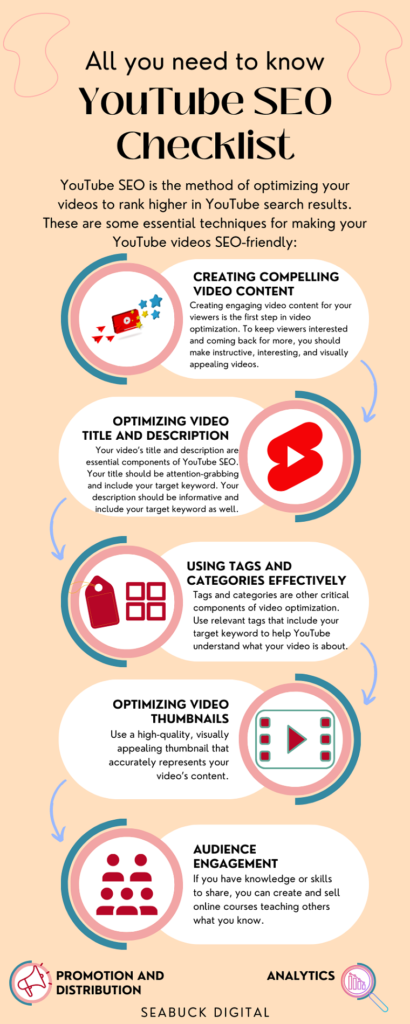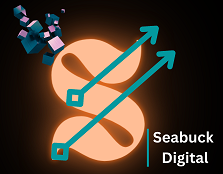I. Introduction
Are you looking to improve your YouTube channel’s visibility and thereby attract more viewers? If it is so then you’ve come to the right place. In today’s digital age, search engine optimization (SEO) has become an essential part of any online marketing strategy. When you talk about YouTube then it is no exception.

A. Explanation of YouTube SEO
YouTube SEO is the method of optimizing your videos to rank higher in YouTube search results. By incorporating certain strategies and techniques, you can increase the visibility of your videos. With the increase in your video’s visibility, you will be able to attract more viewers to your channel.
B. Importance of optimizing YouTube videos for SEO
If you want to grow the audience for your YouTube account, you must make sure that your videos are SEO-optimized. On YouTube, there are millions of videos, making it difficult to stick out and draw viewers. You can increase your search engine rankings, and make it simpler for people to find your content. This will eventually increase traffic to your channel by optimizing your videos for SEO.
C. Purpose of the article
This article’s main goal is to give you a thorough checklist of YouTube SEO tactics. The article will also provide techniques that you can use to optimize your videos and grow your channel. We’ll cover everything from keyword research to video optimization, audience engagement, promotion and distribution, analytics and optimization, and future trends in YouTube SEO. You’ll have a clear grasp of YouTube SEO by the end of this article. You will be well on your way to expanding your channel and drawing in more viewers.
So, let’s get started!
Key Takeaway

II. Keyword Research

Keyword research is one of the most crucial steps in the process when it comes to YouTube SEO. By identifying the right target keywords, you can optimize your videos and improve your search engine rankings. Here’s what you need to know:
A. Identifying target keywords
The first step in keyword research is to identify the target keywords for your videos. These are the words and phrases that people are using to search for content related to your niche. Start by brainstorming a list of keywords that are relevant to your channel and content. Then, use YouTube’s search bar to see what related keywords are being suggested. You can also use Google’s Keyword Planner to get more keyword ideas.
B. Using keyword research tools
Once you have a list of potential keywords, it’s time to use keyword research tools to evaluate their potential. There are several tools available, such as Ahrefs, SEMrush, and Keyword Tool. These tools can help you analyze the search volume and competition for your target keywords. Look for keywords with high search volume and low competition, as these will be easier to rank for.
C. Analyzing search volume and competition
When evaluating your target keywords, you want to look for a balance between search volume and competition. Keywords with high search volume and low competition will be the easiest to rank for, but they may not be the most relevant to your content. On the other hand, keywords with low search volume and high competition may not be worth targeting. Look for keywords with a decent search volume and moderate competition, as these will be the most valuable for your YouTube SEO efforts.
In conclusion, keyword research is a critical step in optimizing your YouTube videos for SEO. You can raise your search engine rankings and draw more viewers to your channel by choosing the ideal target keywords and using keyword research tools to assess their potential.
III. Video Optimization

After you’ve finished your keyword research, you should concentrate on optimizing your videos. These are some essential techniques for making your YouTube videos SEO-friendly:
A. Creating compelling video content
Creating engaging video content for your viewers is the first step in video optimization. This includes everything from the topic and content of the video to the production quality and editing. To keep viewers interested and coming back for more, you should make instructive, interesting, and visually appealing videos.
B. Optimizing video title and description
Your video’s title and description are essential components of YouTube SEO. Your title should be attention-grabbing and include your target keyword. Your description should be informative and include your target keyword as well. Include links to your website and social media accounts in your description to provide more information about your video.
C. Using tags and categories effectively
Tags and categories are other critical components of video optimization. Use relevant tags that include your target keyword to help YouTube understand what your video is about. In order for your video to show up in the correct search results, be sure to choose a suitable category.
D. Optimizing video thumbnails
Your video’s thumbnail is the first thing people see when scrolling through YouTube search results. Use a high-quality, visually appealing thumbnail that accurately represents your video’s content. Consider including text or other graphics on your thumbnail to make it stand out and grab viewers’ attention.
In conclusion, video optimization is crucial for improving your YouTube SEO and attracting more viewers to your channel. By creating compelling video content, optimizing your title and description, using tags and categories effectively, and optimizing your video thumbnails, you can improve your search engine rankings and grow your audience.
IV. Audience Engagement

The next stage is to communicate with your audience and motivate them to engage with your content after you’ve optimized your videos for SEO. Here are some strategies for increasing audience engagement on YouTube:
A. Encouraging likes, comments, and subscriptions
Likes, comments, and subscriptions are all essential metrics for measuring audience engagement on YouTube. By encouraging feedback and thoughts from your viewers, you can get them to like and comment on your videos. Don’t forget to encourage visitors to follow your channel so they won’t miss any upcoming content.
B. Using interactive elements in videos
Interactive elements like polls, quizzes, and annotations can increase viewer engagement and keep them interested in your content. Use these elements strategically throughout your videos to keep viewers engaged and encourage them to take action.
C. Engaging with viewers in the comments section
Engaging with your viewers in the comments section is a crucial part of building a community on YouTube. Respond to comments on your videos and ask questions to encourage further discussion. This will help you build a devoted fan base. This will also increase your overall engagement on the platform.
In conclusion, audience engagement is essential for building a successful YouTube channel. Encourage likes, comments, and subscriptions, use interactive elements in your videos, and engage with your viewers in the comments section to build a loyal fan base and increase your overall engagement on the platform.
V. Promotion and Distribution

It’s time to market your videos and reach as many viewers as you can after you’ve made and optimized them. Here are some strategies for promoting and distributing your YouTube videos:
A. Sharing videos on social media platforms
Sharing your videos on social networking sites like Facebook, Twitter, and Instagram is an excellent way to reach a wider audience. Post your videos on social media and let your fans watch, like, and share them with their own networks.
B. Embedding videos on websites and blogs
Embedding your YouTube videos on your website or blog is a fantastic strategy to enhance exposure and increase traffic to your channel if you have a website or blog. A call-to-action should be included at the conclusion of each video to entice visitors to visit your website or blog for additional content.
C. Collaborating with other YouTubers
A fantastic method to grow your following and attract new viewers is to collaborate with other YouTubers in your industry. Find other creators with a similar audience and work together on a video or series of videos. This can help you tap into their audience and increase your own reach and engagement.
D. Running YouTube ads
YouTube offers a variety of advertising options that will help you to promote your videos. Promotion will help you to reach a wider audience. You can run ads before, during, or after other videos, or promote your videos in search results or on the YouTube homepage. This may be a fantastic strategy to improve the number of views and engagement on your videos by putting them in front of a certain audience.
In conclusion, promoting and distributing your YouTube videos is essential for increasing your reach and engagement on the platform. Share your videos on social media. Embed them on your website or blog. Collaborate with other YouTubers. You can also consider running YouTube ads to get your content in front of a wider audience.
VI. Analytics and Optimization

Tracking your video performance and making adjustments based on your analytics is key to improving your YouTube SEO and increasing your overall success on the platform. Here are some tips for tracking and optimizing your videos:
A. Tracking video performance with YouTube Analytics
A strong tool that offers information on how your videos are doing on the platform is YouTube Analytics. It can tell you everything from the number of views and watch time to engagement metrics like likes, comments, and shares. Use this data to identify your most successful videos and areas for improvement.
B. Identifying areas for improvement
It’s crucial to pinpoint areas for development after you have a solid grasp of how your videos are doing. Examine your video retention rates to determine where viewers are waning, your engagement metrics to determine which videos are receiving the most likes and comments, and your click-through rates to identify the most persuasive video titles and thumbnails.
C. Adjusting video content and optimization strategies
Based on your analytics, make adjustments to your video content and optimization strategies to improve your performance. For example, if you notice that viewers are dropping off early in your videos, try to make your intros more engaging. If your click-through rates are low, try experimenting with different video titles and thumbnails.
In conclusion, tracking and optimizing your videos is essential for improving your YouTube SEO and increasing your overall success on the platform. Use YouTube Analytics to track your performance. It will also help you to identify areas for improvement by which you can make adjustments to your content. You can then build optimization strategies based on your data. With consistent monitoring and optimization, you can continue to improve your performance and grow your audience on YouTube.
VII. Conclusion
A. Recap of YouTube SEO Checklist
- Keyword Research
- Video Optimization
- Audience Engagement
- Promotion and Distribution
- Analytics and Optimization
B. Importance of ongoing optimization and monitoring
Keep in mind that YouTube SEO is a continuous effort. You must continuously analyze and modify your strategies as the platform changes and user behavior shifts in order to stay one step ahead of the competition. Don’t be afraid to experiment with a new strategy. However, always measure the results to see what works best for your channel.
C. Future trends in YouTube SEO.
Certain crucial developments in the field of SEO are important to watch out for as YouTube grows and changes. For example, as voice search becomes more popular, optimizing your videos for voice search queries will become increasingly important. Additionally, as YouTube’s algorithm continues to prioritize watch time and engagement, creating longer videos and more interactive content may become even more crucial for success on the platform.
In conclusion, by following the YouTube SEO Checklist and keeping up with ongoing optimization and monitoring, you can increase your visibility, drive more traffic to your videos, and grow your audience on the platform. To stay ahead of the competition, keep an eye on upcoming trends and be prepared to modify your strategy as necessary. Good luck!
VIII. FAQs
How do you do SEO on YouTube?
You can do SEO on YouTube by optimizing your video titles, descriptions, tags, and using closed captions, engaging thumbnails, and high-quality content.
What does YouTube SEO include?
YouTube SEO includes optimizing your videos and channel for higher visibility and engagement through keyword research, metadata optimization, video optimization, audience engagement, and more.
Which SEO is best for YouTube channel?
The best SEO for a YouTube channel includes optimizing videos for relevant and high-ranking keywords, creating engaging content, using eye-catching thumbnails, using closed captions, and engaging with your audience.
What is an ideal YouTube SEO checklist?
An ideal YouTube SEO checklist should include the following items:
- Keyword research and analysis
- Title and description optimization
- Video tags optimization
- Thumbnail optimization
- Closed captions and transcripts
- Video length and engagement metrics
- Channel optimization (including banner, profile picture, and about section)
- Consistent content creation and scheduling
- Audience engagement and community building
These elements can help ensure that your YouTube channel is optimized for search and can attract a wider audience and higher engagement over time.
Read More:

